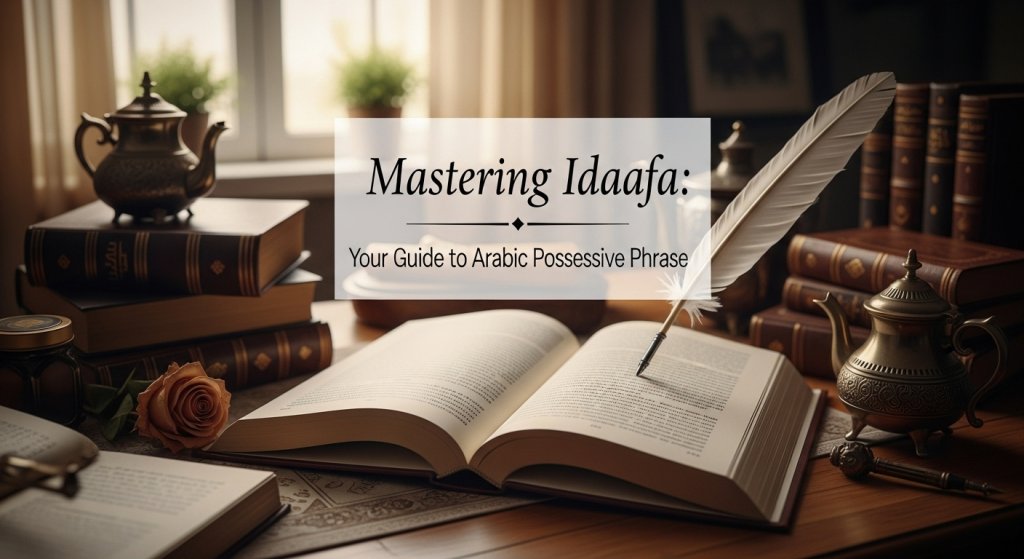At its heart, the Idaafa is a grammatical structure in Arabic that links two nouns together, where the second noun specifies or belongs to the first. It’s often translated into English using the preposition “of” or by using possessive adjectives (like “my,” “his,” “her,” “their”). Understanding what is Idaafa in Arabic is crucial for anyone learning the language, as it appears frequently in everyday speech and written texts
Let’s break down the two key components of an Idaafa construction:
- المضاف (al-mudhaaf): This is the first noun in the construction. Think of it as the “possessed” or the “specified” noun. A crucial rule to remember is that al-muḍāf never takes the definite article (الـ al-) and never takes tanween (nunation), which are the -un, -in, -an endings indicating indefiniteness.
- المضاف إليه (al-mudhaaf ilayhi): This is the second noun, the one that “possesses” or specifies the first noun. This noun is always in the genitive case (مجرور majroor), meaning it typically ends with a kasrah (-i) or its equivalents (like -ayni for dual and -īna for masculine plural).
Let’s explore some Idafa Arabic examples:
Simple Possessions:
- كِتَابُ الْوَلَدِ (kitaabu al-waladi): The book of the boy (The boy’s book).
- كِتَابُ (kitaabu): book (al-mudhaaf – no al- and no -un)
- اَلْوَلَدِ (al-waladi): the boy (al-mudhaaf ilayhi – in the genitive case)
- قَلَمُ الْمُعَلِّمَةِ (qalamu al-muʿallimati): The pen of the teacher (The teacher’s pen).
- قَلَمُ (qalamu): pen (al-muḍāf – no al- and no -un)
- اَلْمُعَلِّمَةِ (al-muʿallimati): the teacher (al-mudhaaf ilayhi – in the genitive case)
Specification and Relationships:
The Idhaafa meaning extends beyond simple possession to indicate various relationships and specifications:
- بَابُ الْبَيْتِ (baabu al-bayti): The door of the house (The house door).
- Here, the second noun specifies which door we are talking about.
- Here, the second noun specifies which door we are talking about.
- مَاءُ النَّهْرِ (maaʾu an-nahri): The water of the river (The river water).
- This indicates the origin or source of the water.
- This indicates the origin or source of the water.
- طَالِبُ الْعِلْمِ (Taalibu al-ʿilmi): A student of knowledge (A knowledge seeker).
- This describes the type or category of the student.
Idhaafah Construction: Key Takeaways
To solidify your understanding of Idhaafah construction, remember these crucial points:
- The first noun (al-mudhaaf) loses its definite article (al-) and its indefinite endings (tanween).
- The second noun (al-mudhaaf ilayhi) is always in the genitive case (majroor).
- The Idhaafah creates a close semantic link between the two nouns, indicating possession, specification, or a relationship.
- The entire Idafa phrase acts as a single noun unit within a sentence.
Beyond the Basics: Nuances of Idhaafah
While the basic structure is straightforward, the Idhaafah can have subtle variations and implications. For instance, the first noun can sometimes be definite through context, even though it doesn’t carry the al- prefix. This is particularly true when the noun has already been mentioned or is a proper noun
Furthermore, the Idafa is a fundamental building block for more complex grammatical structures in Arabic. Mastering it will significantly enhance your ability to understand and form accurate and natural-sounding Arabic sentences.
Conclusion: The Power of Connection
In conclusion, mastering the Idaafa is your key to unlocking a more elegant and precise level of Arabic. By understanding the relationship between al-muḍāf and al-muḍāf ilayhi, you move beyond single words and begin connecting ideas like a native speaker.
Ready to master this and other essential grammar rules? You can learn Arabic and its grammar effectively with the Kaleela app. Download Kaleela App today and take your skills to the next level!



